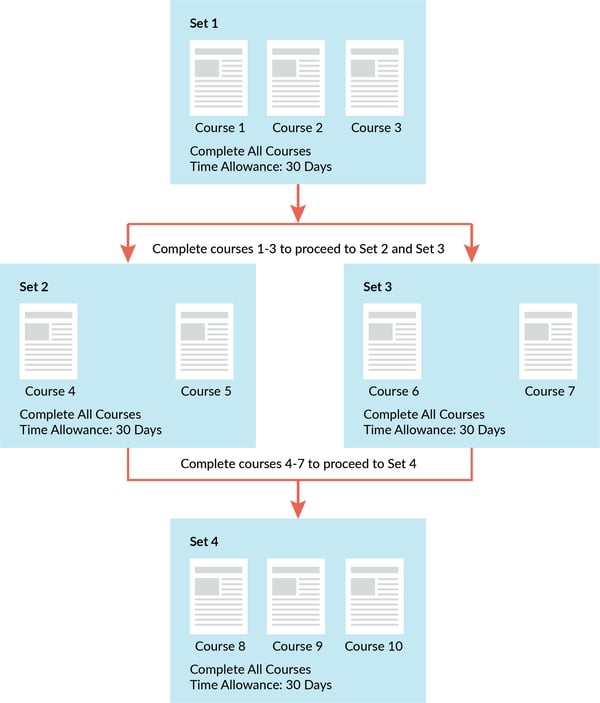Learning plans are a great way to develop personal learning pathways, which give employees an active role in their training.
This post explains what learning plans are, why they work, and how learning plans function in Totara Learn LMS.
What are Learning Plans?
Learning plans defined: Learning plans are a tool found within Learning Management Systems. They’re designed to give learners, and those overseeing learning, one place to share progress. This makes them useful for developing personal learning—individualized training pathways for every employee, department, or role within your organization.
To make full use of a learning plan, you need to know a few things about your learner and their aims. A learning goal is required, which helps shape the overall plan. Competencies and objectives are then used to populate that plan. Alongside these aims is all the support you’ll be providing—the assistance and resources needed to develop and apply newfound skills.
On most platforms, learning plans are highly customizable. They can be adapted to suit a variety of employee roles and needs—even set up to support independent learning, where your team self-manages their own training. For a better idea of how an LMS brings flexibility into training and HR, try our Totara User Guide Part 1: Getting Started.
Why Learning Plans?
1. Competency-based Training
Learning plans are designed around goals and aims, so they’re a great way to focus training on concrete, identifiable outcomes. This is good news for trainers and trainees alike. For learners, competency-based training makes their successes obvious. While for managers, it’s immediately clear where attention needs to be spent, as well as who may or may not be trained/certified for certain tasks.
2. Clear Workflows and Communication
Because learning plans are modular, they can be built to represent real-life workflows and training needs. This applies to the type, but also the priority, of training. Features such as setting due-dates and adding comments show learners exactly where their next task should be.
Learning plans in Totara Learn LMS support communication in both directions. Learners and managers can add comments to a whole plan or individual items. Users can also speed up training by attaching evidence of prior certification to relevant components—and appraisals can be integrated to promote reflection on what was or wasn’t achieved.
3. Personal Learning
The advantage of training with an LMS is that it makes the learning experience personal, while at the same time giving educators complete oversight of their class (To see how an LMS achieves this, read our Totara User Guide Part 2: Basic Features). For learning plans, this means empowering employees to play an active role in how their training is designed.
Personal learning is relevant to new hires as well as experienced team members. For onboarding, learning plans are a great way of encouraging communication about expectations and requirements. New hires can easily see the steps needed to fully undertake a new role, or to progress through internal hierarchies.
Learning Plans in Totara Learn
Let’s look at how learning plans function in Totara Learn. There are three key aspects to setting up and managing a plan—assigning plans, selecting workflows and designing components.
(Tip: Learning Plans in Totara Learn have different features than in Moodle. If you’re not sure which platform best suits your needs, this post might help: Moodle or Totara: Which LMS is Right for Me?)

Reference: Totara Learn 12
1. Assigning Plans and Courses
A basic but necessary first step: to start a learning plan, you need to assign the appropriate plan to the right user. User profiles help to show who will benefit from particular learning plans and training courses, as well as which courses they’re already enrolled in. For learning plans that apply to certain titles and positions, bulk-assignment is available via the Audiences tab. It’s also possible to automatically assign learning plans, based on an employee’s role and their user history (see below).
2. Workflows
With users assigned, the next step in setting up a learning plan is to choose how you’d like your workflow to function. In Totara Learn, educators have the option of designating workflows in three ways. Learning plans can be being user-driven, allowing learners to choose their own training, goals and competencies as they see fit. Manager-driven workflows are assigned, topdown to learners—useful for mandatory training. And custom workflows let admins define their own settings and permissions; another way to make learning plans more personally relevant.
3. Components
The real ‘stuff’ inside a Totara learning plan are the components, to which training items are added. These are courses, competencies, objectives and programs. Administrators can set permissions to determine which of these components users can access.
Once courses and the plan itself has been assigned (see above), a competency framework can be applied. Competency frameworks are the basic structure used to record learners’ current credentials, and highlight areas for progression. Common competencies that might make up a framework include role-specific technical skills, core competencies related to company vision and workplace culture, and leadership expectations for managers.
 Reference: Lambda Solution Support Article
Reference: Lambda Solution Support Article
Within each competency are specific objectives and programs—these are the steps learners need to take to become competent. The status and priority of each learning objective can be modified, allowing learners to self-manage and send approval requests when they’re finished.
4. Automation
Totara learning plans operate on a templated basis—meaning that, once you have the template you need, you can bypass the previous three steps. Auto-creating learning plans is a serious efficiency-booster for larger organizations, as you’ll only need to spend time developing each learning plan once. Going forward, every new user who becomes a member of a certain group (role, department, etc.) is assigned to the corresponding plan. To see how automation aids administrators across the wider LMS, take a look at the final installment in our guide: Totara User Guide Part 3: Advanced Features.
Whether you’re looking to implement learning plans with your Learning Management System, are looking to optimize your LMS and eLearning programs with learning analytics, or need any other eLearning solutions for your business like selling online training courses, we have the expertise to help you reach your goals.
Contact us today. We’d love to help you create a better way to learn!
Related Resources:






